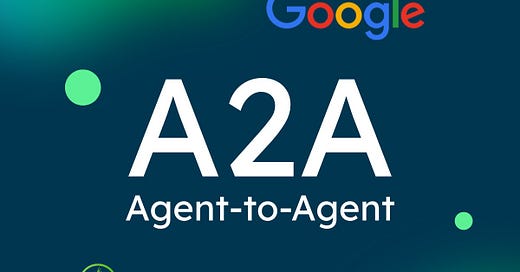Google Agent-to-Agent (A2A) Protocol: What it means for AI, Business, and Developers
Google recently announced Agent-to-Agent (A2A) protocol that might accelerate Agentic AI development! Learn what A2A is and how it could have impact on AI, business, and developers.
Original post is in our Github repo here.
AI agents are evolving far beyond simple assistants. We're entering an era where they can collaborate like human teams—solving complex tasks, coordinating across systems, and adapting to user needs in real time. Google’s Agent-to-Agent (A2A) protocol is poised to accelerate that transformation.
In this post, I’ll break down what A2A is, how it compares and complements the Model Context Protocol (MCP), and why it matters for businesses and developers building AI-driven applications.
1. What Is A2A and How Does It Work?
Agent2Agent (A2A) is Google’s open protocol for enabling secure, collaborative communication between AI agents across different platforms and tools. It lays the foundation for true multi-agent systems—where agents can discover each other, coordinate tasks, and exchange data, even when they don't share memory or tools.
Core Capabilities of A2A
A2A introduces a standardized way for two types of agents to interact:
Client Agent: Initiates a task (e.g., "Summarize this meeting" or "Book a flight").
Remote Agent: Executes the task (e.g., accesses calendars, checks flight availability).
Their interaction is built on several foundational elements:
Agent Cards: JSON-based profiles that advertise an agent’s capabilities. Client agents use these to find the best-fit remote agents for a task.
Task Lifecycle: Each task progresses through a defined lifecycle and results in an "artifact" (e.g., a report, image, or video).
Messaging and Collaboration: Agents exchange context, replies, artifacts, and negotiate how to present information.
User Experience Negotiation: Agents tailor outputs based on user interface capabilities—like whether to use a web form, iframe, video, etc.
Five Design Principles Behind A2A
Embrace Agentic Behavior: Agents are treated as autonomous collaborators, not just tools. A2A supports flexible, unstructured workflows.
Build on Standards: A2A is built on HTTP, JSON-RPC, and Server-Sent Events (SSE), making integration with enterprise stacks seamless.
Secure by Default: Offers enterprise-grade authentication and authorization mechanisms.
Support for Long-Running Tasks: Ideal for tasks that span hours or days, with built-in feedback loops and state updates.
Modality Agnostic: Supports various content types, including text, audio, and video—essential for multimodal interactions.
2. How A2A and MCP Compare and Work Together
While A2A defines how agents communicate with each other, Anthropic’s Model Context Protocol (MCP) governs how agents interact with the broader world.
What Is MCP?
The Model Context Protocol is an open standard developed by Anthropic. It allows AI models to access real-time context from external tools, data sources, and APIs—enhancing their ability to reason and act effectively. MCP standardizes how a model can:
Discover and call available tools
Retrieve contextual data from external systems
Execute structured tool or function calls
Think of MCP as an AI agent’s gateway to the world of external knowledge and services.
A2A vs. MCP: Side-by-Side
FeatureA2AMCPMain PurposeAgent-to-agent communicationModel-to-tool/data interactionProtocol Built ForTask delegation and coordinationExternal context retrieval and tool usageArchitectureMulti-agentClient-serverData Types SupportedMessages, artifacts, modalitiesTool calls, structured data, API access
How They Complement Each Other
These protocols are designed to work together:
A client agent uses A2A to assign a task to a remote agent.
The remote agent then uses MCP to access external data or tools to complete the task.
Together, A2A and MCP enable intelligent, dynamic, and tool-empowered collaboration between agents.
3. Impact on Businesses and Developer Teams
For Businesses Adopting AI
Streamlined Integration: A2A standardizes agent communication, reducing integration headaches across tools and vendors.
Ecosystem Interoperability: Supports modular, scalable AI solutions that are not tied to a single platform.
Enterprise-Ready Architecture: Built-in security, long-task handling, and modality support make it ideal for internal and external applications.
Faster Time-to-Value: With open standards and open-source tools, companies can accelerate development and deployment.
For Developer Teams
Developer-Friendly Framework: The open-source Agent Development Kit (ADK) makes it easy to build agents quickly.
Focus on Business Logic: Developers can prioritize task logic and agent behaviors over communication mechanics.
Standards-Based Tooling: Integration with HTTP and JSON standards simplifies debugging and deployment.
Rapid Prototyping: A2A supports iterative workflows and experimentation.
Future-Proof Architecture: Adopting A2A and MCP today prepares developers for tomorrow’s ecosystem of interoperable agents.
Final Thoughts
Google’s A2A protocol is a significant step toward a more open and collaborative AI landscape. Paired with MCP, it lays the groundwork for intelligent systems where agents can not only communicate across platforms but also take meaningful action using real-world data and tools.
Together, A2A and MCP empower agents to interact with each other and the world—making them foundational building blocks for the next wave of agentic AI.
If you’re building AI-powered products or developing next-gen applications, now is the perfect time to explore A2A and start building with these standards.









